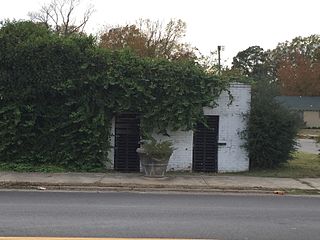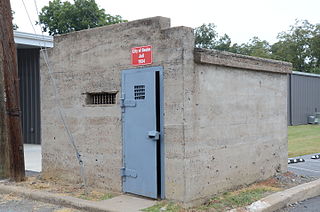
City Market is a historic building located in downtown Davenport, Iowa, United States. It was individually listed on the National Register of Historic Places in 1984. In 2020 it was included as a contributing property in the Davenport Downtown Commercial Historic District.

Powhatan Historic State Park is a 9.1-acre (3.7 ha) Arkansas state park in Lawrence County, Arkansas in the United States. The park contains the 1888 Powhatan courthouse which served as the home of county government from 1869-1968. Today the structure displays items of cultural and historical significance and hosts the park's Visitor Center. The park includes four additional historical buildings and the Arkansas History Commission's Northeast Arkansas Regional Archives. A tour of the historic structures is available. Powhatan served as an important stop for traffic on the Black River until the installation of the Kansas City-Memphis Railwayline two miles north in 1883 significantly decreased the need for river transportation.

The Marcella Church & School is a historic multifunction building on Arkansas Highway 14 in Marcella, Arkansas. It is a single-story wood frame structure, with a gable roof, weatherboard siding, and a small belfry. The side elevations each have five windows, and the front's only significant feature is the double-door entrance. Built about 1900, it is a typical and well-preserved example of a building used both as a local schoolhouse and as a church.

Hermitage City Hall and Jail is a historic building at 112 South Oak Street in Hermitage, Arkansas. A modest single story yellow brick building probably built in the 1940s, its front section served as Hermitage City Hall, and the rear as the city jail, until 2000.

The former McGehee City Jail is a historic building at South First and Pine Streets in McGehee, Arkansas. The small single story brick building was built in 1908, and served as the city jail until 1935. The building's roof is made of concrete, and it has three cells, each with a separate outside door. All openings in the building are covered with heavy metal bars, and the doors are solid metal. Even though this building has sat vacant since 1935, it has survived the jail that was built to replace it.

The Smackover Historic Commercial District encompasses the civic and commercial heart of the small town of Smackover, Arkansas. It consists of sixteen buildings lining a single block of Broadway north of 7th Avenue. The area is reflective of Smackover's explosive growth following the discovery of oil in 1925; most of the buildings were built between 1925 and 1940. They are mostly vernacular commercial buildings, one or two stories in height, with flat roofs obscured by a parapet on the main facade. Also included in the district are the Methodist Episcopal church, the old fire station, and the old city hall and jail. The district was listed on the National Register of Historic Places in 1990.

The Prescott City Jail is a historic city jail behind the city hall of Prescott, Arkansas. The modest single-story structure was built for the city in 1912 by the Southern Structural Steel Company. It is built of reinforced concrete, with metal grates covering unglazed window openings, and a doorway that is reinforced with heavy metal shutters. It was built to replace an early jail, from which a suspect involved in the burglary of a prominent citizen's home had escaped, in part due to its poor condition. This building, housing three cells, served the city until the 1960s.

The New Rocky Comfort Jail is a historic jail, located at the southeast corner of 3rd and Schuman Streets in Foreman, Arkansas. It is a single story wooden structure, resting on concrete block piers and topped by a metal gable roof. Its walls are constructed out of stacked two-by-six pine, and its floor and ceiling are out of similar material, laid on edge. The main rectangular block was built in 1902, and an entry vestibule was added to the south side sometime before 1928. The floor was later covered with a conventional pine floor, and part of the interior was partitioned for an office and bathroom. The building, which has served variously as a jail, city hall, meeting hall, library, and dance hall, now houses the New Rocky Comfort Museum.

The Goff and Gamble Merchandise Store is a historic retail establishment in the center of Gillham, Arkansas, just north of the railroad tracks. Built in stages between 1900 and 1911, it is one of the few surviving structures in the community dating to its boom years in the early 20th century. The first section of the building, built 1900, has a wooden storefront topped by a metal cornice, and is the westernmost part of the building. The central section, built out of concrete blocks in 1906, has an entrance facing north, with that elevation topped by a parapet. The eastern section, completed in 1911, is also fashioned from concrete blocks. Its storefront also faces north, flanked by pilasters, and also topped by a simple parapet.

The Old Gillett Jail is a historic former city jail at 207 Main Street in Gillett, Arkansas. It is a single-story brick structure, housing two cells and a small entry vestibule. Its windows have vertical iron bars over them, and the door is made of solid metal. The roof is made of metal. It was built in 1922, and served as the city jail until about 1972.

The Old Sebastian County Jail is a historic former jail in Greenwood, Arkansas. It is a two-story stone building, located just east of the Sebastian County Courthouse on the south side of Arkansas Highway 10 in the city center. It was built 1889-91 by Ike Kunkel, a local master mason, and is one of the city's finest examples of cut stone masonry. It is also believed to be the oldest county government building. It was used primarily as a holding jail for detainees awaiting transport to facilities in Fort Smith, and is now operated by the South Sebastian County Historical Society as a local history museum known as the Old Jail Museum.

The Old Huntington Jail is a historic jail at 223 East Broadway in Huntington, Arkansas. It is a single-story stone structure, fashioned out of courses of cut stone. It was built in 1888 by the Kansas and Texas Coal Company, a mining concern that platted and founded Huntington in 1887. The interior has a central access space with two small cells on the right, and one large one on the left. The jail was in active use into the mid-1950s, and is now part of a local history museum.

The Beebe Jail is a historic jail building in Beebe, Arkansas. The small single-story concrete structure is set on an alley south of East Illinois Street on the east side of North Main Street. It is distinctive for its slightly rounded concrete roof, with a parapet rising above the front (southwest) facade. The interior has two small cells, each with a barred window, and a small vestibule area. The jail was built as a Works Progress Administration project in 1935.

The Old Searcy County Jail is a historic building on Center Street, on the south side of the courthouse square in Marshall, Arkansas. It is a two-story stone structure, built out of local sandstone, with a pyramidal roof topped by a cupola. The front facade, three bays wide, has a central bay that projects slightly, rising to a gabled top, with barred windows at each level. The main entrance is recessed in the rightmost bay. The building's interior houses jailer's quarters on the ground floor and cells on the upper level. Built in 1902, it was used as a jail until 1976, and briefly as a museum thereafter.

The former Newton County Jail is located at the junction of Spring and Elm Streets in Jasper, Arkansas. Built of local stone c. 1903–04, it served as a local lockup until 2009, when a new jail was opened. It is a two-story structure, located just off the courthouse square northwest of the county courthouse. Its main facade has a center entrance flanked by barred windows, and a larger two-leaf casement window, also barred, set in a segmented-arch opening, at the center of the second floor.

The Gillham House is a historic house in rural Garland County, Arkansas. It is located north of the hamlet of Royal, about 0.5 miles (0.80 km) north of United States Route 270 on the east side of Gillham Road. It is a single story log dogtrot, with a side gable roof and a shed-roof porch across the front. Its original log structure is visible, with its log pens fastened by V-notch and center-notch joints. The house was built about 1866 by Philip Gillham, a Union Army veteran of the American Civil War.

The McRae Jail is a former local jail on East First Street in McRae, Arkansas. It is a small single-story masonry structure, built out of cast concrete. It has a single door with a barred opening, and small openings on the sides, also barred. Built about 1934 with funding from the Works Progress Administration (WPA), it is one of three jails built in White County by the WPA, and is of those three the best preserved.

The Russell Jail is a historic town holding facility in Russell, Arkansas. It is located near the town post office, in a field at the junction of West Elm Street and Highway Avenue. It is a small single-story concrete structure, with a slightly bowed roof, a doorway opening on one wall, and small square barred openings on the sides. It was built about 1935 with funding support from the Works Progress Administration, and is one just three such structures in White County.

The Magazine City Hall-Jail is a historic government building at the northwest corner of Garland and Priddy Streets in Magazine, Arkansas. It is a single-story masonry structure, built out of rusticated concrete blocks and covered by a gable roof. The gable ends are framed in wood. The rear portion of the building, housing the jail cells, has a flat roof. It was built in 1934, with the concrete blocks formed by a local mason to resemble ashlar stone. It is the only local municipal building built out these materials, and was used for its original purposes into the 1980s.

In the United States, a one-room jail is a type of jail with only one room, or cell.






















